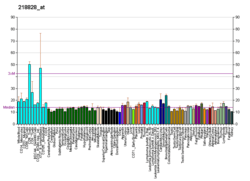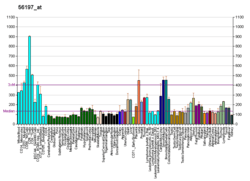PLSCR3
Phospholipid scramblase 3 is an enzyme that in humans is encoded by the PLSCR3 gene [5][6] (abbreviated to PLS3 in this section). Like the other phospholipid scramblase family members (PLS1, PLS2, PLS4), PLS3 is a type II plasma membrane protein that is rich in proline and integral in apoptosis, or programmed cell death. The regulation of apoptosis is critical for both cell development and tissue homeostasis [7]
Although phospholipid scramblase is thought to exist in all eukaryotic cells, PLS3 is a protein that is novel to the mitochondria.[8] This is very important because mitochondria are central in the apoptotic cell pathway. This newly found member of the scramblase family is "responsible for phospholipid translocation between two lipid compartments," [7] the inner mitochondrial membrane and the outer membrane. Further experimental evidence suggests that the mechanism and effectors of PLS3's enzymatic activity are rather nuanced.
Effect on mitochondrial cardiolipin
Cardiolipin is a mitochondrion-specific phospholipid found in both the mitochondrial inner and outer membranes[9] Many studies speculate that cardiolipin is a likely player in mitochondrial apoptosis. In a study done by R Lee et al., it was found that during apoptosis, cardiolipin in the outer membrane of the mitochondria increased from 10% to 30% saturation. Finding that cardiolipin concentration in the outer mitochondrial membrane increased during apoptosis (as well as knowing the function that PLS3 plays in mitochondrial apoptotic effects) clued Lee in to the fact that PLS3 may have effects on this cardiolipin membrane redistribution. Lee’s study looked into the consequences of cardiolipin redistribution in the mitochondria and found that cardiolipin plays a critical role in proteins that are involved with oxidative respiration (such as ATP synthase), which in turn affects ATP production. In Lee's experiment determining the effect of cardiolipin deprivation on cells, he studied an infected yeast mutant that lacked a cardiolipin creating enzyme, and found that although it was viable, the yeast was "moderately deficient in mitochondrial energy transforming machinery."
It was subsequently deduced that PLS3 is an effector for the redistribution of cardiolipin from the inner to outer mitochondrial membrane. Thus, when PLS3 flips cardiolipin across the inner to outer membrane of the mitochondria, the oxidative phosphorylation induced is greatly disturbed. It was deduced experimentally that a lack of proper oxidative phosphorylation is directly linked with mitochondrial apoptosis. Thus, this PLS3-induced redistribution of cardiolipin during apoptosis has major effects on mitochondrial function.
Summary
Although the results of the experiments above are very intriguing and shed light on what was once a mystery, there have been only a few experiments that have targeted PSL3. And, furthermore, in a majority of the experiments and studies that were reviewed, it is evident that there is some doubt in the experimental findings [10][11][12]
See also
References
- 1 2 3 ENSG00000284009 GRCh38: Ensembl release 89: ENSG00000187838, ENSG00000284009 - Ensembl, May 2017
- 1 2 3 GRCm38: Ensembl release 89: ENSMUSG00000019461 - Ensembl, May 2017
- ↑ "Human PubMed Reference:".
- ↑ "Mouse PubMed Reference:".
- ↑ Wiedmer T, Zhou Q, Kwoh DY, Sims PJ (Jul 2000). "Identification of three new members of the phospholipid scramblase gene family". Biochimica et Biophysica Acta. 1467 (1): 244–53. PMID 10930526. doi:10.1016/S0005-2736(00)00236-4.
- ↑ "Entrez Gene: PLSCR3 phospholipid scramblase 3".
- 1 2 Liu J, Dai Q, Chen J, Durrant D, Freeman A, Liu T, Grossman D, Lee RM (Oct 2003). "Phospholipid scramblase 3 controls mitochondrial structure, function, and apoptotic response". Molecular Cancer Research. 1 (12): 892–902. PMID 14573790.
- ↑ Wiedmer T, Zhou Q, Kwoh DY, Sims PJ (Jul 2000). "Identification of three new members of the phospholipid scramblase gene family". Biochimica et Biophysica Acta. 1467 (1): 18240–4. PMID 10930526. doi:10.1016/S0005-2736(00)00236-4.
- ↑ A1 USA patent US20060172958 A1, Ruey-min Lee; Jun Chen & Jihua Liu, "Phospholipid scramblase 3", published 2006-08-03
- ↑ Pomorski T, Menon AK (Dec 2006). "Lipid flippases and their biological functions". Cellular and Molecular Life Sciences. 63 (24): 2908–21. PMID 17103115. doi:10.1007/s00018-006-6167-7.
- ↑ Frasch SC, Henson PM, Kailey JM, Richter DA, Janes MS, Fadok VA, Bratton DL (Jul 2000). "Regulation of phospholipid scramblase activity during apoptosis and cell activation by protein kinase Cdelta". The Journal of Biological Chemistry. 275 (30): 23065–73. PMID 10770950. doi:10.1074/jbc.M003116200.
- ↑ Sahu SK, Gummadi SN, Manoj N, Aradhyam GK (Jun 2007). "Phospholipid scramblases: an overview". Archives of Biochemistry and Biophysics. 462 (1): 103–14. PMID 17481571. doi:10.1016/j.abb.2007.04.002.
Further reading
- He Y, Liu J, Grossman D, Durrant D, Sweatman T, Lothstein L, Epand RF, Epand RM, Lee RM (Aug 2007). "Phosphorylation of mitochondrial phospholipid scramblase 3 by protein kinase C-delta induces its activation and facilitates mitochondrial targeting of tBid". Journal of Cellular Biochemistry. 101 (5): 1210–21. PMID 17226776. doi:10.1002/jcb.21243.
- Van Q, Liu J, Lu B, Feingold KR, Shi Y, Lee RM, Hatch GM (Jan 2007). "Phospholipid scramblase-3 regulates cardiolipin de novo biosynthesis and its resynthesis in growing HeLa cells". The Biochemical Journal. 401 (1): 103–9. PMC 1698660
 . PMID 16939411. doi:10.1042/BJ20060373.
. PMID 16939411. doi:10.1042/BJ20060373. - Rual JF, Venkatesan K, Hao T, Hirozane-Kishikawa T, Dricot A, Li N, Berriz GF, Gibbons FD, Dreze M, Ayivi-Guedehoussou N, Klitgord N, Simon C, Boxem M, Milstein S, Rosenberg J, Goldberg DS, Zhang LV, Wong SL, Franklin G, Li S, Albala JS, Lim J, Fraughton C, Llamosas E, Cevik S, Bex C, Lamesch P, Sikorski RS, Vandenhaute J, Zoghbi HY, Smolyar A, Bosak S, Sequerra R, Doucette-Stamm L, Cusick ME, Hill DE, Roth FP, Vidal M (Oct 2005). "Towards a proteome-scale map of the human protein-protein interaction network". Nature. 437 (7062): 1173–8. PMID 16189514. doi:10.1038/nature04209.
- Liu J, Dai Q, Chen J, Durrant D, Freeman A, Liu T, Grossman D, Lee RM (Oct 2003). "Phospholipid scramblase 3 controls mitochondrial structure, function, and apoptotic response". Molecular Cancer Research. 1 (12): 892–902. PMID 14573790.
- Liu J, Chen J, Dai Q, Lee RM (Mar 2003). "Phospholipid scramblase 3 is the mitochondrial target of protein kinase C delta-induced apoptosis". Cancer Research. 63 (6): 1153–6. PMID 12649167.





